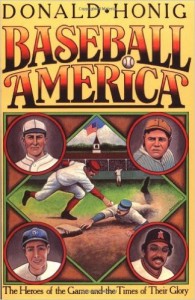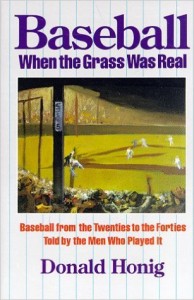The Wonderful Writings of Donald Honig
December 15, 2015 by Mike Durell · Leave a Comment
 Donald Honig is perhaps best known for picking up the mantle of Lawrence Ritter and carrying on the valuable work of preserving the history of the National Pastime through the oral reminiscences of ballplayers. But a closer look at his body of work reveals much more than interviews. In his towering history of baseball, Baseball America
, Honig represents the USA through the lens of the five seasons: Spring, Summer, Winter, Fall, and Baseball.
Donald Honig is perhaps best known for picking up the mantle of Lawrence Ritter and carrying on the valuable work of preserving the history of the National Pastime through the oral reminiscences of ballplayers. But a closer look at his body of work reveals much more than interviews. In his towering history of baseball, Baseball America
, Honig represents the USA through the lens of the five seasons: Spring, Summer, Winter, Fall, and Baseball.
One immortal at a time.
For example, who was/is the greatest shortstop of all time? Ozzie Smith? Cal Ripken? Bud Harrelson? How about a vote for Honus Wagner? There was a time when shortstop was the only uncontested position when it came to debates over the Best Ever. Wagner at short. Case Closed. Not so much these days, old Honus seems to have fallen off the radar a bit. Perhaps his versatility worked against him in a strange way; in the majors he played every position except pitcher and catcher and by all accounts was always the best player on every team he was with, regardless of what position he was manning that day. It took a while before his destiny as best shortstop ever became apparent. Did he feel a vague sense of unfulfillment while playing another position? Probably not. He was one of those folks who has a joie de vivre which is strongest on the diamond.
Donald Honig left school at sixteen, after an attendance record that might charitably be described as uneven, He went to work in his father’s grocery, lived and died with the Brooklyn Dodgers, and commiserated with neighbor Jimmy Ring, who had pitched for four National League teams in a career that lasted from 1917 to 1928, finishing with a final slate of 118-149 (In fairness, it must be said that Ring spent most of his career with woeful Phillies teams.) Mr. Ring provided an actual link to the majors for the baseball-mad youngster as well as valuable encouragement when Honig embarked on his own path into professional baseball.
Playing sandlot ball in and around his hometown of Maspeth, New York, he was spotted pitching by various freelance scouts, ‘bird dogs’ in baseball parlance, and was offered contracts by the Phils, Reds, Cubs, and his local Yankees and Giants, although not the Dodgers. The fledgling pitcher was unimpressed by these clubs but felt that the Boston Red Sox had a certain cachet, mostly because of the hitting and the aura of ol’ Teddy Ballgame, aka Ted Williams, who the author had seen slamming fat pitches into the Yankee Stadium stands on more than one occasion. So Honig signed with the Sox and was shuttled off to Savannah, Georgia, to try and stick on the roster of the Milford, Delaware nine of the Eastern Shore League in the spring of 1948. (A friend and teammate was future Red Sox hot corner man Frank Malzone.)
Quickly he found out a hard truth: the game that was so easy on the sandlots of Queens was much more difficult when everyone on the field is a similar stud. But while cut from the Milford squad quickly, Honig’s professional experience would set him apart from most baseball writers, whose main form of exercise at that time seems to have been the bending of elbows. Honig found he had the discipline to write, and to persevere when faced with the constant rejection common to all creative types, as glittering a gift as was his roundhouse curve which awed Maspeth’s sandlotters. While his novels were well-received, significant sales were not forthcoming and when his editor at Coward-McCann publishing offered a contract for another fictional tome, Honig demurred and noted that novels took time and that what he really needed was a way to make money to support his family, which by now included a baby daughter. So editor Bill Henderson, aware of Honig’s love of the game, suggested a book on baseball.
Most baseball fans who are also bibliophiles rightly revere the grandaddy of oral histories, The Glory of Their Times , by Lawrence Ritter. So far as is known, only one person ever tried to persuade the professor to publish a sequel. That was Honig himself, a fellow member in good standing of the Bobo Newsom Memorial Society. Named after the offbeat pitcher whose career encompassed five separate stints with the Washington Senators and who won (and lost) over 200 games in the big leagues, this informal group would gather in Manhattan several times per year for lively discussions of the National Pastime, made all the livelier by adult beverages. Thus did Honig speak to Ritter about the latter’s monumental work of baseball history.
 In fact Professor Ritter did not follow up ‘Glory,’ one reason being that he had in a way become a victim of the book’s success. Interviewees were more guarded, more rehearsed, more glib, and the freshness and relaxed atmosphere that contributed mightily to the tone of the book was missing, a victim of self-consciousness. So Ritter was disinclined to carry on and in fact gave his blessing to Honig to carry on the tradition. This led directly to two of the worthy successors to Ritter’s groundbreaker, Baseball When the Grass Was Real
, and Baseball Between the Lines
, which cover players who enjoyed careers in what some feel is the heyday of big league baseball, the era leading up to and just after World War II.
In fact Professor Ritter did not follow up ‘Glory,’ one reason being that he had in a way become a victim of the book’s success. Interviewees were more guarded, more rehearsed, more glib, and the freshness and relaxed atmosphere that contributed mightily to the tone of the book was missing, a victim of self-consciousness. So Ritter was disinclined to carry on and in fact gave his blessing to Honig to carry on the tradition. This led directly to two of the worthy successors to Ritter’s groundbreaker, Baseball When the Grass Was Real
, and Baseball Between the Lines
, which cover players who enjoyed careers in what some feel is the heyday of big league baseball, the era leading up to and just after World War II.
But Honig took the genre one step further, with The Man In the Dugout , which gave beleaguered managers a chance to air their opinions, and The October Heroes , telling the tales of noteworthy performers in the Fall Classic. In addition to the reminiscences of former baseballists, Honig published a book of vintage photographs, which do much to recall and preserve our memories of the National Pastime, Classic Baseball Photos 1869-1947 . Game action shots and portraits from yesteryear with Hall of Famers and journeymen alike make the history of the game come alive in a different, perhaps more immediate way than the prose, be it written or verbal.
In the publishing of an oral history the usual protocol is to eliminate the interviewer’s questions, and lightly edit so as to avoid repetition, as well as some basic fact checking to ensure accuracy of statistics. But there is an art, a real skill to provide a proper presentation to engage the reader. Consider the opening sentence in the chapter on Hall of Famer Joe McCarthy, from The Man in the Dugout : “I never played ball in the big leagues. Not one game, wasn’t good enough, I guess.”
Few Hall of Famers would be confident enough in the arc of their careers to state such a negative fact right off the bat, but right then the reader (or at least this reader) is interested and wants to know more. Read on in the canon of Donald Honig to learn of Ernest Hemingway’s drunken but good-natured brawl with Dodger reliever Hugh Casey in Cuba.
 Or from Paul Richards: “I remember Joe Cronin pinch hitting against us one time when I was catching for Detroit. We threw him five consecutive fastballs and ran the count to three and two. I figured now’s the time for the curve. So I called for it and the pitcher busted off as good a curve as you could throw, and Cronin hit it in the seats. I’ve never been able to understand that. Was he guessing? How could he be guessing after five fastballs? To this day it
Or from Paul Richards: “I remember Joe Cronin pinch hitting against us one time when I was catching for Detroit. We threw him five consecutive fastballs and ran the count to three and two. I figured now’s the time for the curve. So I called for it and the pitcher busted off as good a curve as you could throw, and Cronin hit it in the seats. I’ve never been able to understand that. Was he guessing? How could he be guessing after five fastballs? To this day it
worries me.”
And that is why baseball is the greatest game in the world, and chroniclers like Ritter and Honig make sure through their efforts and fine writing that the great moments and characters will forever be remembered.
In not only continuing Ritter’s invaluable contribution to baseball and American history, but forging a path of his own, Donald Honig has created a body of work that takes its place among the pantheon of great baseball literature.
Bobo Newsom would have been proud.
Baseball When The Grass Was Real , Coward, McCann & Geoghegan, 1975. Baseball Between The Lines , Coward, McCann & Geoghegan, 1976. The Man In The Dugout , Follett Publishing, 1977. Classic Baseball Photographs 1869-1947 , aka Shadows of Summer , Penguin, 1994. The Fifth Season , Ivan R. Dee, 2009. The October Heroes , Simon and Schuster, 1979.

